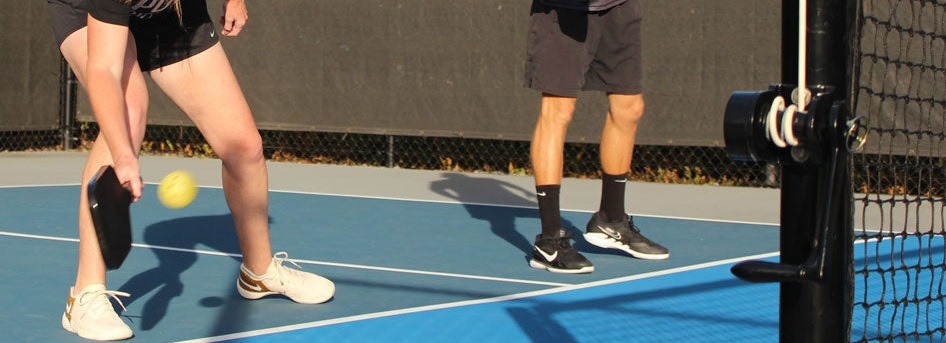
Drills to Improve Your Dinking
Mastering the art of dinking in pickleball can be both exhilarating and frustrating for your opponents. This shot requires impeccable timing, finesse, and a significant amount of practice. As the saying goes, practice makes perfect, and this article delves into the world of dinking, highlighting its benefits, and providing you with the best drills to elevate your dinking game to new heights.
TIPS AND TRICKS
2/7/20234 min read


Mastering the art of dinking in pickleball can be both exhilarating and frustrating for your opponents. This shot requires impeccable timing, finesse, and a significant amount of practice. As the saying goes, practice makes perfect, and this article delves into the world of dinking, highlighting its benefits, and providing you with the best drills to elevate your dinking game to new heights.
Understanding the Essence of Dinking
Dinking involves executing a slow, high-arcing shot that gracefully glides over the net and lands in the kitchen, just beyond your opponent's reach. The primary objective of this shot is to decelerate the pace of the game and prolong the volley, with the hope of forcing your opponent(s) into making an error. Typically, dinks are initiated from the kitchen line, which marks the boundary of the non-volley zone, and can often initiate a series of dinking exchanges between you and your opponent. If you've ever witnessed a match where players are positioned near the kitchen, casually exchanging shots, then you've witnessed the art of dinking in action.
Unveiling the Hidden Power of Dinking
Although dinking may appear deceptively simple, it holds the potential to become a game-changer. This seemingly innocuous shot serves as a catalyst for setting up a game-winning opportunity later in the match. By strategically placing your opponent(s) in compromising positions, dinking forces them to make mistakes, ultimately leading to victory for you and your partner. So, while it may seem like the players are engaged in a casual back-and-forth, the underlying strategy and skill involved in dinking should not be underestimated.
There are numerous advantages to incorporating dinking into your pickleball game:
It Slows Down the Game
Firstly, dinking can help slow down the pace of the game, which can be beneficial for various reasons. For instance, if your opponent tends to play aggressively and quickly, dinking can disrupt their rhythm and throw them off balance.
Additionally, if you find yourself less agile or unable to move swiftly around the court, dinking allows you to control the tempo and buy yourself some time to strategize. Moreover, some players simply prefer a slower-paced match, and dinking provides the perfect opportunity to set the pace according to your liking.Helps to make your move
Another significant benefit of dinking is that it enables you to choose the right moment to make your move. Many beginners make the mistake of trying to score on every shot, which often leads to errors and missed opportunities. By engaging in dinking exchanges, you can patiently wait for the perfect opportunity to execute a winning shot instead of rushing into low-probability scoring attempts. This strategic approach allows you to capitalize on your opponent's mistakes and control the flow of the game more effectively.Best Defensive tactic
Lastly, dinking serves as a valuable defensive tactic in pickleball. Novice players sometimes overlook the importance of defense in the game, focusing solely on offense. However, dinking plays a crucial role in defensive strategies by slowing down the game and forcing your opponent into challenging positions on the court. While dinking may not result in immediate points, it can create opportunities for your opponent to make errors that you can exploit later in the match. By incorporating dinking into your gameplay, you can enhance your defensive skills and increase your chances of winning points through strategic play.
Perfecting Dinking Technique
Practice makes perfect, especially when it comes to mastering the dink shot in pickleball. Without consistent practice, it's hard to improve your skills on the court. So, grab a partner and head to an empty court to start honing your dinking abilities.
Focus on Footwork
Maintaining the right position on the court is crucial for successful dinking. Keep your feet close to the non-volley zone line to ensure you're in the best spot to execute the shot. Use cones or chalk to create a guideline parallel to the kitchen line, and practice staying within that boundary while your partner dinks the ball back to you.Develop Touch and Precision
To enhance your feel for the dink shot, try tossing balls over the net with an underhand motion. The goal is to softly land the ball in your opponent's kitchen area. This drill helps you gauge the power and swing needed for a successful dink. Additionally, set up targets inside the kitchen on the other side of the net to practice aiming at specific spots during your dinking shots.Practice Dinking with Friend
Get a group together and split up on opposite sides of the net. Stand at the kitchen line and focus on practicing your dinking shots. Remember, the goal here is not to score points, but to simply work on your dinking technique without the pressure of a real match.Focus on Specific Dinking Skills
During the practice match, try to concentrate on improving a specific aspect of your dinking game. Whether it's hitting the ball shallower or aiming for different spots on the court, honing in on one area can help you see quick improvements in your overall game.Play a Competitive Dinking Match
If you're feeling competitive, add a twist to the practice by playing for points. Establish rules that require you to dink for a few shots before opening up the game to any shot. Remove serves from the match and start with all players at the non-volley zone line to focus solely on dinking skills.
sales@pickleballtek.com
Socials
Subscribe to our newsletter
(949) 456-0000
